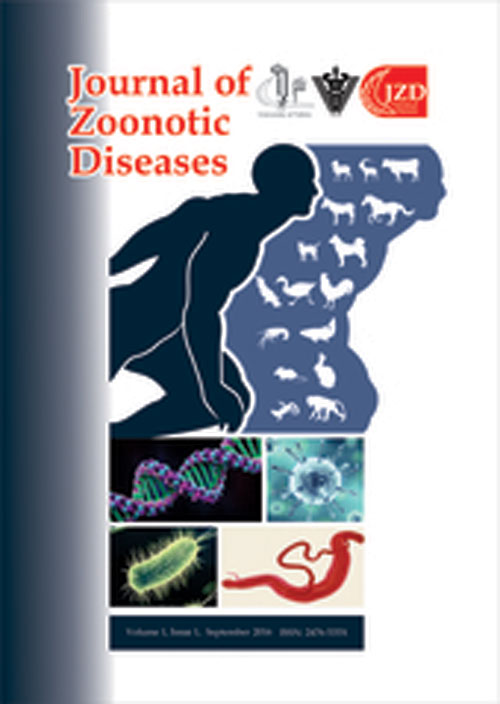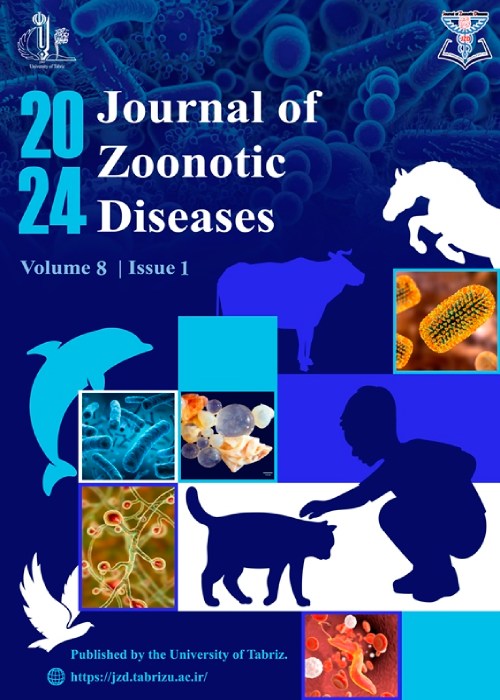فهرست مطالب

Journal of Zoonotic Diseases
Volume:5 Issue: 1, Spring 2021
- تاریخ انتشار: 1400/02/01
- تعداد عناوین: 6
-
-
Pages 1-8SummaryRabies is a neglected tropical zoonotic disease, causing the majority of global human rabies deaths in developing countries of Asia and Africa. The objective of the study was to identify the social and demographic characteristics of the residents and pet (dogs and cats) owners of Kathmandu Metropolitan City. A cross-sectional study was carried during March - April 2017 to assess the community awareness and knowledge towards rabies by applying a semi-structured questionnaire. Awareness level was high on rabies about its cause (87.5%) and symptoms (91.94%). All respondents have knowledge that it is transmitted by the bite of rabid animals (100%), is a fatal disease (85.63%), is a vaccine preventable (96.25%), and is curable (60%) if treated before the onset of clinical symptoms. All the respondents would visit a hospital after being bitten by a stray dog/cat, while only (56.43%) of respondents would visit a hospital if being bitten by a pet dog/cat (56.43%). Furthermore, 87.36% of them reported that they would visit the hospital on the day of the bite. The respondents had positive attitudes and practices towards rabies as all the pet owners had vaccinated their pets against rabies, 98.28% mentioned that they would notify the concerned authorities in case of rabies outbreaks; approximately 47.41% will kill a rabid stray dog and either bury it or inform the municipality for its proper disposal. The results indicate the knowledge gaps about rabies in the community that could be improved by a rabies awareness campaigns, public health education, and vaccination campaigns.Keywords: Awareness, rabies, knowledge, Nepal
-
Pages 9-17In the present study, we evaluated the impact of animal-origin food consumption on the recent pandemic of Coronavirus-19 (COVID-19). Thus, the relationship among animal-origin food supply as independent factor and total cases of COVID-19 as a dependent variable was assessed. In this regard, the relevance between the consumption quantity of foods (n = 20) and TC of COVID-19 in worldwide countries (n = 215) was evaluated. For more details, we studied the number of total case (TC) as a dependent variable and food supply as an independent variable. Food supply (kg/capita/yr.) was estimated in each country based on the latest available data of FAO. The results showed an association between a group of animal-origin foods and TC. Regression, Bayes, and Lasso ҆ s findings demonstrated that eggs and freshwater fish have a high positive correlation with TC. We suppose an important role for animal-origin foods concerning COVID-19 as a cross-contamination pathway. In conclusion, a noticeable vehicle for SARS-Cov-2 may be some of the animal-origin foods. The perspective is the development of surveillance of SARS-Cov-2 in the food production chain. Also, chicken‘s eggs and freshwater fish may be leading vehicles for SARS-Cov-2 by cross-contamination.Keywords: Animal, Covid-19, foodborne, SARS-cov2
-
Pages 18-28Escherichia coli (E. coli) bacteria areone of the most important pathogens in the poultry industry and a leading cause of cellulitis, septicemia, and airsacculitis infections. Antimicrobial resistance in pathogenic E. coli is of particular interest because it is the most common gram-negative pathogen in chickens. Cloacal, eggs, and environmental samples were randomly collected from three commercial farms in Zambia. Specimens were cultured and phenotypically identified pathogenic E. coli using Congo red dye-binding test (CR-test). The pathogenic E. coli underwent antimicrobial susceptibility testing for six antibiotics. The study aimed to isolate and determine antimicrobial resistance patterns of pathogenic E. coli from chickens in Chisamba and Lusaka districts. A total of 417 samples were collected and processed microbiologically. E. coli was isolated from 333(79.9%; 95%CI=75.23-82.98) samples. The highest number was isolated from cloacal swabs 313(75.1%; 95%CI=70.19-78.52%) while 18(4.3%; 95%CI=2.75-6.72%) was from litter in poultry houses, and 1(0.2%) of each from eggs and environment swabs. Of 333 isolates, 62(18.6%; 95%CI=14.90-23.28%) were pathogenic. The bacteria demonstrated 100% and 92% resistance to tetracycline and cephalexin, respectively, while 77% were susceptible to gentamicin. The results also showed that 4.8% of pathogenic isolates exhibited multidrug resistance (MDR) to all six antibiotics combined, while 17.7% were resistant to five antibiotics. The isolation of antimicrobial-resistant pathogenic E. coli suggests that the bacteria were exposed to these antibiotics before sampling. The resistant bacteria are a serious public health concern, causing ailments that are difficult to treat with antimicrobial drugs. Consequently, there is a need to intensify education campaigns on bio-security measures and good-hygienic practices.Keywords: Antimicrobial resistance, Chicken, Pathogenic Escherichia coli
-
Pages 29-36Summary Direct rapid immuno-histochemical test (DRIT) is used as a gold standard method for rabies virus detection. The present study aimed to compare and evaluate DRIT with direct fluorescent antibody test (DFAT) to use equivalently as one of rabies diagnosing methods in areas where DFAT is not accessible. The method is based on the capture of rabies nucleoprotein (N) antigen in brain smears using a cocktail of biotinylated monoclonal antibodies specific for the N protein and color development by streptavidin peroxidase-amino ethyl carbazole and counterstaining with hematoxylin. The test was performed in parallel with the standard DFAT and mice inoculation test (MIT) using 100 brain specimens from various species of animals. The majority of them were dogs (n =88), followed by cats (n =8), cattle (n =3), and donkey (n =1), and also from those samples that were tested by DRIT and DFAT, we randomly selected and tested 12 brain samples by MIT. The results indicated that 63% of the tests were positive by DFAT and 64% were positive by DRIT. A slight difference was observed in such a way that one sample was negative by DFAT but positive by DRIT and MIT. Although, further laboratory and field examinations are essential, our findings were providing and remark the potential value of the DRIT for countries with limited diagnostic resources.Keywords: DRIT, rabies, MIT, DFAT, Surveillance
-
Pages 37-43
Summary Coenurosis is a neurological parasitic infection of sheep caused by the larval stage of Taenia multiceps. In spring 2020, several animals were referred from different flocks (10 sheep herds) to the Clinic of Faculty of Veterinary Medicine, Urmia University, Iran with a history of acute neurological dysfunctions associated with increased mortality. Affected animals were 5-8 months years-old from the mixed breed and both sex. Physical and ophthalmoscopic examinations were performed. The cerebrospinal fluid (CSF) samples were obtained from the lumbosacral region and were examined grossly and microscopically. The CSF examination showed a mixed population of mononuclear cells with a predominance of small lymphocytes and reduced number of monocytes. Neutrophils were also occasionally observed. Dissection of the brain revealed ventricular deformity Coenurus cerebralis with white protoscolices causing the obstruction of the ducts and thus resulting in internal hydrocephalus and lateral ventricles enlargement. This study, as the first report of the epidemic incidence of cerebral coenurosis in sheep from Urmia, Iran, implies a failure of prevention and control measures against a parasitic disease. Thus, regular chemical-prophylactic protocols of dogs and correct disposal of the infected brain upon slaughtering or death of animals to prevent scavenging by dogs can control it.
Keywords: Taenia multiceps, Coenurosis, Sheep, Outbreak, Cerebrospinal fluid -
Pages 44-48
Summary Sarcocystosis is a zoonotic disease in sheep caused by an intracellular parasite belongs to the phylum Apicomplexa, order Eucoccidioria, and Sarcocystidae family. In the parasite life cycle, there is a need for an intermediate host and a definite host. Some species of Sarcocystis can cause disease and consequently cause weight loss, anorexia, fever, anemia, muscle weakness, decreased milk production, abortion, and sometimes death in intermediate hosts such as cattle, goats, and sheep. Cysts of Sarcocystis spp. are found nearly always in skeletal, striated muscles, particularly in the diaphragm, heart, liver, lungs, and esophageal. A six-years-old native ewe was referred to the veterinary clinic in Najafabad, Isfahan province, Iran with major clinical signs of nasal discharge, enlarged superficial lymph nodes, anorexia, and a round tumor-like mass on the back. After tissue processing and hematoxylin and eosin staining, different sizes of Sarcocystis spp. (with 3.03 ± 0.44 µm in length) each surrounded by a thin layer of muscle fibers and contained banana-shape bradyzoites were seen in the subcutaneous muscle fibers. Hemorrhage and infiltration of inflammatory cells, mainly, neutrophils were also seen in the dermis.
Keywords: Sarcocystosis, Ewe, Histopathology, Case report


